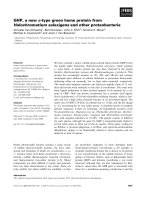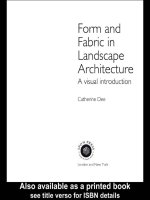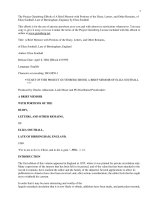Montgomery schuyler american architecture and other writings pot
Bạn đang xem bản rút gọn của tài liệu. Xem và tải ngay bản đầy đủ của tài liệu tại đây (36.86 MB, 358 trang )
^Architecture
Writings
by Montgomery
Schuyler
EDITED
BY
WILLIAM H.
JORDY
AND
RALPH
COE
Praised in 1914
by
Frank
Lloyd
Wright
as
the
single
critic
who
was
sympathetic
to
his work and
by
Lewis
Mumford
twenty
years
later as
the most
significant
turn-of-the-century
American
architec-
tural
critic,
Montgomery
Schuyler
fol-
lowed
the
development
of American
architecture from
1880
to
his
death
in
1914.
Throughout
these
years
he
ob-
served from
one
firm
point
of
view
the
flamboyant
spectacle
of a
wealthy
nation
building
its own
image.
In
his comments
on Victorian
Gothic,
Richardsonian
Romanesque,
the
esthetics
of
bridge-building,
the rise
of the
sky-
scraper,
the Beaux
Arts
reaction,
and
the
works
of Louis
Sullivan
and
the
early
Wright,
Schuyler
reveals the dilemma
of
a
progressive
architectural
idealism
forged,
in the mid-nineteenth
century,
called
upon
to
assess
the
simultaneous
appearance
of
academism
and
early
mod-
ern
architecture.
The
time:
a
critical
moment in
American
cultural
history.
The
core
of
this two
-volume
edition
of
Schuyler's
writings
is
his
American Archi-
tecture,
a
collection of
seven
essays
pub-
lished
in
book
form in
1892, These
essays
have
long
been
recognized
as
among
the
most
perceptive
and urbane
criticism of
American
architecture.
The book
has
been out
of
since
its
original pub-
lication.
Moreover,
it
does
not
contain
any
of
Schuyler's
work
written after
1892,
and
therefore
omits some
of his
major
contributions.
Readers have
hitherto
had
to
search
for
scattered
articles
by
Schuy-
ler that
were
buried
in
back
numbers of
AS CITY,
MO-
PUBLIC. LIBRARY,,
tt
'
720,975
Sj9am
v*l
61-28275
Schiayier
American
architectxire
and
other
720*975
Sj9am
v.l
61-28275
Sch-uyler
$12-50
American
architecture
and
other
writingi
Kansas
city
public
library
i
Kansas
city,
missouri
f
Books
will
be
issued
only
on
presentation
of
library
card,
Please
report
lost cards and
change
of residence
promptly,
Card
holders are
responsible
for
all
books, records, films,
pictures
or
other
library
materials
checked
out on
their cards,
JOHN
HARVARD
LIBRARY
Howard
Mumford
Jones
Editor-in-Chief
and Other
Writings
by
MONTGOMERY SGHUYLER
Edited
by
William
H.
Jordy
and
Ralph
Coe
IN TWO
VOLUMES
VOL.
I
THE BELKNAP
PRESS
OF
HARVARD
UNIVERSITY
PRESS
Cambridge,
Massachusetts
1961
i
$6
i
by
the President
and
Fellows
of
Harvard
College
All
rights
reserved
Distributed
in
Great Britain
by
Oxford
University
Press
9
London
Library
of
Congress
Catalog
Card Number
6*-
Printed
in the
United
States
of
America
Preface
In
1891 Montgomery Schuyler
published
a
volume of his
essays
under
the
modest
title American Architecture
Studies.
Culled
from
magazine
articles
which
had
appeared
during
the
preceding
decade,
the
seven
essays
in
this volume
have
long
been
recognized
as
among
the
most
perceptive,
urbane,
and
progressive
critical
writings
on
certain
aspects
of
nineteenth-century
American architecture.
Although
much consulted
by
historians
of both
American
culture
and modern
architecture,
American Architecture
has been
out
of
since the sale
of its
initial edition.
The
essays
included
in American
Architecture,
however,
represent
only
a lesser fraction
of
Schuyler's
extensive architectural criticism
of
American
developments
from the seventies
to the
year
of
his death in
1914.
Many
of his
significant
writings
do
not
appear
in
this
early
volume. Moreover
there has hitherto
been no
attempt
to
survey
Schuyler's
criticism
as
a
whole. Hence we
have
arranged
an
extensive
sampling
of
Schuyler's
criticism
so.
that
it
parallels
the
historical
development
of American architecture
in
the late nineteenth and
early
twentieth
centuries.
The
essays
collected in
American
Architecture,
to-
gether
with the
vignetted
line
drawings
of
the
original publication,
have
been distributed
among
the
other
writings.
The
editing
of
Schuyler's essays
has
presented
certain difficulties.
The
least
important,
but
the most
vexatious,
is
inconsistency
in
spelling,
punctuation,
capitalization,
and
the like. Since
Schuyler
published
in
many
different
magazines, copyediting
style inevitably
changed
from
periodical
to
periodical.
Variations
even
occur within
single
articles.
We have
maintained the
original
style
of
each
article,
correcting
for
consistency
within
the
essay
when
ftecessary.
vi
PREFACE
The
second
problem
centers
In
Schuyler's
fondness
for
the
elaborate,
elliptical
allusion,
maddeningly
calculated
to
conceal
its
source.
For
example,
remarks
are
attributed
to an
"English
visitor
11
;
an
article
appears
in "an architectural
journal";
certain
bridges
in
the
"southern
tier"
of
New
York
State
are
"within
sight
of
the
Erie railroad."
The
frequent
difficulties
in
tracing
the
sources
of such
nebulous
references
are
compounded
by
the
nineteenth-century
habit
of
lavish
literary
allusion.
Since
Schuyler
was
broadly
read
and,
according
to
his
son
Robert
Livingston
Schuyler, possessed
an
uncanny
memory,
these
allusions
have
occasionally
not
only
shamed
his editors
but
puzzled
specialists
as
well.
Let
it be
said,
however,
that
the
reason references
have
sometimes
gone
unlocated
is not
want of
trying.
Like
many
journalists
with
prodigious
memories,
Schuyler
did not
always
go
back
to
his sources
for
his
allusions.
Hence
minor
inaccuracies
are
frequent.
Finally,
Schuyler's
numerous
references
to now
forgotten buildings
present
the
greatest
problem
in
editing
his criticism.
In
every
instance
we
have
attempted
to
ascertain
the
architect,
address
(especially
important
for research
in New York
City
architecture),
and
date
of
the
building,
as well as
whether or not
it still exists.
Here
the contri-
butions of hundreds of
correspondents
have
been more
helpful
than
guides
and directories. Those
who
wish such documentation
as
is
available,
as
well
as additional
illustrations,
may begin
by
consulting
the
following
works. On
architects,
the most convenient
starting
point
is
Henry
F.
and
Elsie
R.
Withey,
Biographical
Dictionary
of
American
Architects
(Deceased] (Los
Angeles,
1956)
and
the
Dictionary of
American
Biography.
On the
architecture of New
York
City,
the
basic
guidebook
sources
appear
in
Winston
Weisman,
"Commercial
Palaces of New
York:
1845-1875,"
Art
Bulletin,,
$6
(Dec. 1954),
285-302.
Of
these,
the
most
useful
have
been Moses
King's
Handbook
of
New
York
City
(Boston,
2nd
ed.,
1893);
Record and
Guide>
A
History
of
Real
Estate^
Building
and
Architecture
in
New
York
during
the
Last
Quarter
of
a
Century
(New
York,
1898);
Karl
Baedecker,
The United
States
(Leipzig,
1909),
which is
helpful
as
well
for the
architecture
of other
cities;
finally,
Isaac
N.
Phelps
Stokes,
The
Iconography
of
Manhattan
Island
(New
York,
6
vols.,
1915-1928).
Chicago
architecture
is
covered in the
bibliography
listed
on
p.
246n
below. On
bridges,
see
comparable
listings
on
pp.
33
in
and
332n
below,
together
with
the
bibliographies
contained
in
the
volumes
cited.
On
Richardson,
the
standard
work
is
Henry-Russell
Hitchcock,
PREFACE
vii
The
Architecture
of
H. H.
Richardson
and
His Time
(New
York,
1936;
a
second,
revised edition is
scheduled for
publication);
on
Sullivan,
Hugh
Morrison,
Louis Sullivan
(New
York,
1935), John
Szarkowski,
The
Idea
of
Louis Sullivan
(Minneapolis, 1956),
Albert
Bush-Brown,
Louis
Sullivan
(New
York,
1960),
and,
soon to
appear,
Richard
Nickel,
The
Complete
Works
of
Louis
Sullivan;
on
Wright,
Henry-Russell
Hitch-
cock,
In
the
Nature
of
Materials
(New
York,
1942)
and Grant C.
Manson,
Frank
Lloyd
Wright:
The
First
Golden
Age (New
York,
1958).
The
most
recent
general
architectural
history
including coverage
of
the
period
of
Schuyler's writing
is
John
Burchard and
Albert
Bush-Brown,
The
Architecture
of
America:
A
Social and
Cultural
History
(Boston,
1961).
To
the numerous
correspondents
about three
hundred
in
all
who
helped
on
individual
queries,
we
are
most
grateful.
Certain
individuals
and institutions were
particularly helpful.
In
New York
City,
we
are
especially
indebted
to
Philip
A. Rees
and
A.
K.
Barag-
wanath
of
the
Museum of
the
City
of New
York
and
to
Robert C.
Goodrich of
the
Engineering
Societies
Library,
together
with the
staffs of the
New-York Historical
Society
and
the
New
York
Public
Library;
in
Chicago,
to the
staffs
of the
Burnham
Library
of
the
Chicago
Art
Institute,
the
Chicago
Historical
Society,
and
the
Chicago
Public
Library;
in the
Twin
Cities,
to
the
fine arts and
history
staffs
of
the
Minneapolis
Public
Library
and
to
Lois
M.
Fawcett of
the
Minne-
sota
Historical
Society;
in
Buffalo,
to Edith
B.
Krebs of
the
Buffalo
Public
Library;
in
Newport,
to
Gladys
E. Bolhouse
of
the
Newport
Historical
Society;
on
the
building
history
of
the
New
York
State
Capitol,
to Kenneth
DeKay
of
the
Legislative
Research
Office.
Fellow
historians have
also
been
most
generous.
Henry-Russell
Hitchcock
read
the
introduction
in
part,
and Robert
Livingston
Schuyler
read
it all.
Both made
helpful
suggestions.
John
Jacobus
gave
assistance
on
Viollet-le-Duc
and
the
Neo-Grec
movement,
as
did
Allen Brooks on
Leopold
Eidlitz's architecture
(not,
however,
on
Eidlitz's architectural
theory),
and
Wayne
Andrews
on
some
aspects
of
New York
City
architecture.
James
D.
van
Trump
assisted on
problems
pertaining
to
Pittsburgh.
Alan
Burnham,
the editor
of
the Richard
Morris Hunt
Papers,
was
exceptionally
cooperative
in
supplying
in-
formation
and
checking
the
accuracy
of
the
footnoting
for
Schuyler's
essay
on
Hunt. Most
helpful
of
all was
Winston Weisman.
Time
and
time
again
he drew on
his extensive
scholarship
of
nineteenth-century
viii
PREFACE
building
in New
York
City
to answer
questions
which
must
otherwise
either
have
consumed
months
of
labor
on
our
part
or
gone
unanswered.
He
could
not have
been
more
generous
with
his
information
had
these
volumes
been
his
own.
Finally,
a
word
as
to
the
respective
contributions of
the two
editors.
The basis
for
the
introduction
to these
volumes was
an
essay
by
Mr.
Coe.
This
was
elaborated
and
extended
~
especially
with
respect
to
the
material
on
Eidlitz,
bridges,
the Beaux
Arts,
and the final
conclusion
by
Mr.
Jordy.
The
selection,
ordering,
and
editing
of
Schuylcr's
writing
was
done
by
Mr.
Jordy.
The
indexing
was
clone
by
Mr.
Coe
and Mr.
Jordy.
Contents
Vols. I
and
II
"
Montgomery
Schuyler"
by
William
H.
Jordy
and
Ralph
Coe
\
AMERICAN
ARCHITECTURE
and Other
Writings
I THE
POINT
OF VIEW
The
Point
of
View
95
Modern Architecture
99
II
THE
HERITAGE OF VICTORIAN
GOTHIC
The
Works
of Francis
H.
Kimball
121
The
Works
of
Cady,
Berg
&
See
1125
The Work of
Barney
&
Chapman 130
A
Great American Architect:
Leopold
Eidlitz
136
1 .
Ecclesiastical
and
Domestic Work
2.
Commercial
and Public
3.
The
Capitol
at
Albany
III
THE RIGHARDSONIAN
INTERLUDE
The
Romanesque
Revival
in
New
York
191
The
Romanesque
Revival
in
America
200
Recent
Church
Building
in New York
226
An
American Cathedral
229
x
CONTENTS
Glimpses
of
Western
Architecture:
Chicago
246
Glimpses
of
Western
Architecture:
St.
Paul
and
Minneapolis 292
IV
BRIDGES:
RATIONALISTIC
ENGINEERING
The
Brooklyn
Bridge
as a Monument
331
"Monumental
Engineering'
1
345
Art
in
Modern
Bridges
351
New
York
Bridges
372
V SKYSCRAPERS:
RATIONALISTIC
ARCHITECTURE
Architecture
in
Chicago:
Adlcr &
Sullivan
377
D.
H. Burnham & Co.
405
The Evolution
of
the
Skyscraper
419
The
Skyscraper Up-To-Date
437
The
Skyscraper
Problem
442
VI
THE BEAUX ARTS REACTION
Concerning
Queen
Anne
4^3
The
Vanderbilt
Houses
488
The Works of the Late
Richard
M.
Hunt
502
Last
Words
About
the
World's
Fair
556
Schools
of
Architecture and
the
Paris
School
575
A
Long-Felt
Want
579
Architecture
Made
Easy
583
A
Modern
Classic
588
The
New
St.
Thomas'
Church,
New
York
598
The
Woolworth
Building
605
VII
LATE
SULLIVAN
AND
EARLY
WRIGHT
The
People's
Savings
Bank
of
Cedar
Rapids,
Iowa
Louis H,
Sullivan,
Architect
625
An
Architectural
Pioneer:
Review of
the
Portfolios
Contain-
ing
the
Works
of
Frank
Lloyd
Wright
634
BIBLIOGRAPHY
641
INDEX
655
Illustrations
Vol.
I
Frontispiece
Montgomery Schuyler,
c.
age
60.
Courtesy
Robert
Livingston Schuyler.
1.
Russell
Sturgis.
Farnarn
Hall,
Old
Campus,
Yale
University,
New
Haven, Conn.,
1869.
Photograph by
William
H.
Jordy. 4
2. Russell
Sturgis.
Durfee
Hall,
Old
Campus,
Yale
University,
New
Haven, Conn.,
1871. Photograph
by
William
H.
Jordy. 5
3.
Peter
B.
Wight.
National
Academy,
New
York
City,
1862-1
865.
Courtesy
Museum of
the
City
of New York.
6
4.
John
Ruskin, "Torn
Tower,"
Christ Church
College,
Oxford.
Pencil
drawing,
1838.
Courtesy
Fogg
Museum
of
Art,
Harvard
University.
1
7
5.
Henry
Hobson Richardson.
Preliminary
sketch
for
the
massing
of the
Cathedral
of
All
Saints,
Albany,
N.Y.,
1882-1883.
From
Mariana
Van
Rensselaer,
Henry
Hobson Richardson
and His
Works
(Boston
and
New
York,
1888), p. 83.
20
6.
Charles C.
Haight.
Reading
room of
the
old
Library
of
Columbia
University,
New
York
City,
completed
1884.
Cour-
tesy
Columbia
University.
37
7.
William C.
Potter
and
James
Brown
Lord.
Union
Theological
Seminary,
New York
City, 1881-1884.
Courtesy
Union Theo-
logical
Seminary.
38
8.
John
and
Washington
Roebling.
Brooklyn
Bridge
over the
East
River,
New
York
City,
1867-1873.
Courtesy
Museum
of
the
City
of New
York.
49
ii
ILLUSTRATIONS
g.
William
H.
Burr,
engineer.
Winning
design
in the
competition
for
the
Memorial
Bridge
over
the
Potomac,
Washington,
D.C.,
1899.
From
56th
Gong.,
H.
of
Rep.,
Doc.
578,
Memorial
Bridge
Across
the Potomac
River
at
Washington,
D.C.
(Washington,
1900),
pi.
2.
52
10.
Gapt.
Thomas
W.
Symons,
engineer;
Paul
Pel/,,
architect.
Proposed
Grant
Memorial
Bridge
over the
Potomac,
Washing-
ton,
D.C.,
1886.
From
Century
Magazine,
(fa
(May
1900),
22,
53
n.
L. L.
Buck,
chief
engineer.
Williamsburg
Bridge
over
the East
River,
New
York
City,
1896-1903.
Courtesy Department
of
Public
Works,
New
York
City, 54
12.
Gustav
Lindenthal,
engineer;
CamVe
&
Hastings,
architects.
Manhattan
Bridge
over
the East
River,
New
York
City, 1901-
1909.
Courtesy Department
of
Public
Works,
New
York
City.
55
13.
John
B.
Jervis,
engineer. Aqueduct
(High)
Bridge
over the
Harlem,
New
York
City, 1839-1842, Photograph
by
William
H.
Jordy.
Go
14.
Sir
John
Fowler
and
Sir
Benjamin
Baker,
Firth
of
Forth
Bridge,
Queensferry,
Scotland,
1881-1890.
Courtesy
British
Information Service.
n6
15. J.
Cleveland
Cady
and
Henry
M.
Congdon.
Brooklyn
Academy
of
Design,
Brooklyn,
N.Y.,
c.
1875.
l^om
New
Tork tiketch*
Book
of
Architecture,
3 (June
1876),
pi.
22.
127
1
6. Peter
B,
Wight.
Mercantile
Library,
Brooklyn,
N.Y.,
1867.
New
Tork
Sketch-Book
of
Architecture,
5 (Feb.
1876),
pi.
7.
129
17.
Blesch
&
Eidlitz.
St.
George's
Episcopal
Church,
New
York
City,
1846-1850.
Fire
of
1865
showing original
towers and
view of
1890
showing
present
condition.
Courtesy
St,
George's
Episcopal
Church.
138, I'jg
1 8.
Original
interior,
St.
George's
Church.
From Putnam*
s
Maga-
zine,
2
(Sept.
1853),
246.
Courtesy
Allen
Brooks,
140
19.
Leopold
Eidlitz.
Second
Congregational
Church,
Greenwich,
Conn.,
1856-1859.
Photograph by
William
H.
Jordy.
146
20.
Leopold
Eidlitz.
Church
of
the
Holy
Trinity,
New
York
City,
1853.
From
New Tork
Sketch-Book
of
Architecture,
3 (Dec,
1876),
P
L
45-
150
21.
Tower
of
the
Church of
the
Holy
Trinity,
Madison
Ave.
at
42nd
St.,
New
York
City.
Courtesy
Museum
of
the
City
of
New
York.
l
e
l
ILLUSTRATIONS
xiii
22.
Jacob
Wray
Mould. All
Souls
Unitarian
Church,
New
York
City, 1853-1855.
Courtesy
New-York
Historical
Society.
153
23.
Leopold
Eidlitz.
Temple
Emanu-El,
New York
City,
1866-
1868.
Courtesy
Temple
Emanu-El.
156
24.
Interior,
Temple
Emanu-El.
From
Leslies
Illustrated
News,
26
(Oct.
3,
1868),
reproduced
in
Rachel
Wischnitzer,
Synagogue
Architecture
in
the
United
Slates,
p. 77.
158
25.
Leopold
Eidlitz. Continental
Bank,
New
York
City,
1856-
1857.
From ArcMtectural
Record,
24
(Oct.
1908),
280.
164
26.
Leopold
Eidlitz.
Interior
of the
Academy
of
Music,
Brooklyn,
N.Y.,
1860-1861.
From New Tork
Illustrated
Mews,
2
(Feb.
2,
1861)5 77.
Courtesy
Allen Brooks.
169
27. Leopold
Eidlitz.
Dry
Dock
Savings
Bank,
New
York
City,
1875.
From
New
Tork
Sketch-Book
of
Architecture,
3
(Aug. 1876),
pi.
8.
170
28.
Leopold
Eidlitz.
Assembly
Chamber,
New York
State
Capitol,
Albany,
N.Y.,
completed
1878. Courtesy
New
York
State
Library.
1
76
29.
Leopold
Eidlitz. Senate
Corridor,
New
York State
Capitol,
Albany,
N.Y.,
completed
1880.
Courtesy
New
York
State
Library.
1
79
30. Leopold
Eidlitz,
Dining
Room
F,
State
Hospital,
Central
Islip, Long
Island,
N.Y.,
c.
1890.
Courtesy
State
Hospital. 183
31.
Shepley,
Rutan &
Coolidge. Shadyside
Presbyterian
Church,
Pittsburgh,
Pa.,
1889-1890.
Courtesy James
D.
Van
Trump. 204
32. Henry
Hobson
Richardson
and
Shepley,
Rutan &
Coolidge.
Cincinnati
Chamber
of Commerce
Building,
Cincinnati, Ohio,
1885-1887.
From
Architectural
Record,
i
(Oct Dec.
1891),
158.
207
33. Shepley,
Rutan
&
Coolidge.
New
London
Public
Library,
New
London,
Conn.,
1890.
Courtesy
New London Public
Library.
209
34.
Cyrus
L.
W.
Eidlitz.
Buffalo
Public
Library
and
Art
Building,
Buffalo,
N.Y.,
1884-1887.
Plan of the
ground
floor.
Courtesy
Buffalo Public
Library.
2 1 1
35.
McKim,
Mead
&
White,
St.
Peter's
(now
Lovely
Lane)
Methodist
Church,
Baltimore,
Md.,
1883-1887.
Courtesy
Lovely
Lane
Methodist
Church.
215
XIV
ILLUSTRATIONS
36.
Shepley,
Rutan &
Goolidge. Lionberger
Warehouse,
St.
Louis,
Mo.,
1887-1889.
Courtesy
Shepley,
Bulfmch,
Richard-
son
&
Abbott.
217
37.
Shepley,
Rutan &
Coolidge.
Masonic
Building,
Pittsburgh,
Pa.,
1889.
From
Architectural
Record,
i
(Oct Dec.
1891),
188.
218
38.
Shepley,
Rutan &
Coolidge.
Ames
Building,
Boston,
Mass.,
1889.
Courtesy
Shepley,
Bulfinch,
Richardson
& Abbott.
220
39.
Henry
Hobson
Richardson.
Competition
design
for
the Prot-
estant
Episcopal
Cathedral
of
All
Saints,
Albany,
N.Y.,
1882-
1883.
Illustration
from
original
edition
of
Montgomery
Schuy-
ler,
American
Architecture
Studies
(1892).
231
40. Apse,
All
Saints.
Ibid.
235
41.
Plan,
All
Saints.
Ibid.
238
42.
Front
elevation,
All Saints.
Ibid.
241
43.
Transverse section
through
the
choir.
All
Saints.
Ibid.
245
44. Cyrus
L.
W. Eidlitz.
Clock
tower,
Dearborn
Station,
Chicago,
1883.
Ibid.
246
45.
John
M.
Van
Osdel/
J.
J.
Egan
and Alex
Kirkland.
Combined
City
and
County
Building,
Chicago,
completed
1885/1882
respectively.
Ibid.
251
46.
Romanesque
Chicago:
Michigan
Ave.
from
Congress
St.
to
Van Buren St.
Courtesy
Burnham
Library,
Art Institute of
Chicago.
254
47.
Burnham
& Root. Art
Institute,
Chicago,
1886-1887.
From
American Architecture.
255
48.
Entrance,
Art
Institute.
Ibid.
255
49.
Adler
&
Sullivan.
Michigan
Ave.
entrance,
Auditorium,
Chicago,
1887-1889.
Ibid.
258
50.
Tower,
Auditorium. Ibid.
258
51.
Henry
Hobson
Richardson.
Marshall
Field
Wholesale
Store,
Chicago,
1885-1887.
Ibid.
263
52.
S. S.
Beman.
Studebaker
Building,
Chicago,
1884-1886.
Ibid.
266
53.
Cobb
&
Frost.
Owings
Building,
Chicago,
completed
1886.
Ibid.
268
54.
Burnham
&
Root.
Insurance
Exchange,
Chicago,
completed
1885.
Ibid.
271
ILLUSTRATIONS
xv
55.
Burnham &
Root.
Entrance,
Phoenix
Building,
Chicago,
com-
pleted
1886. Ibid.
273
56.
Oriel,
Phoenix
Building.
Ibid.
274
57.
Janua
Richardsoniensis.
N'Importe
Qui,
architect.
Ibid.
279
58.
Henry
Hobson
Richardson.
Franklin
MacVeagh
house,
Chi-
cago,
1885-1887.
Ibid.
281
59.
Henry
Hobson Richardson.
J.
J.
Glessner
house,
Chicago,
1885-1887.
Ibid.
283
60.
Richard
Morris
Hunt. William
Borden
house,
Chicago,
1884.
Ibid.
286
61.
John
Addison.
Front on
Dearborn
Ave.,
Chicago.
Ibid.
288
62.
Burnham &
Root.
A
house
of
boulders,
Chicago.
Ibid.
289
63.
Henry
Ives Cobb.
A
Byzantine
corbel,
Chicago.
Ibid.
290
64.
Long
& Kees.
Minneapolis
Public
Library,
Minneapolis,
Minn.,
completed 1889.
Ibid.
298
65.
Entrance,
Minneapolis
Public
Library.
Ibid.
299
66.
J.
W.
Stevens.
People's
Church,
St.
Paul,
Minn.,
c.
1889.
Ibid.
300
67. Leroy
S.
Buffington.
Unitarian
Church,
Minneapolis,
1885-
1887.
Ibid.
301
68. Gilbert
&
Taylor.
Dayton
Avenue
Presbyterian
Church,
St.
Paul,
completed
1888.
Ibid.
304
69. Leroy
S.
Buffington.
West
Hotel,
Minneapolis,
completed 1883.
Ibid.
305
70.
Thomas
M.
Griffith.
Suspension bridge
at
Anthony
Falls,
Minneapolis,
completed
1855.
Ibid.
307
71.
Long
&
Kees.
Lumber
Exchange,
Minneapolis, .completed
1885.
Ibid.
309
72.
Harry
W.
Jones.
Entrance,
Bank of
Commerce,
Minneapolis,
completed
1888.
Ibid.
310
73.
Corner,
Bank of
Commerce.
Ibid.
311
74.
E. Townsend
Mix. Globe
Building, Minneapolis,
completed
1891.
Ibid.
312
75.
S.
S. Beman.
Entrance,
Pioneer Press
Building,
St.
Paul,
completed
1889.
Ibid.
312
xv
i
ILLUSTRATIONS
76.
Corner,
Pioneer
Press
Building.
Ibid.
3
12
77.
Wilcox
&
Johnston.
Bank
of
Minnesota,
St.
Paul,
completed
'
1387.
Ibid.
3*4
78.
Babb,
Cook
&
Willard.
New
York
Life
Insurance
Building,
St.
Paul, 1888-1889.
Ibid.
3*6
79.
Entrance,
New
York
Life
Insurance
Building,
St.
Paul.
Ibid.
317
80.
Babb,
Cook
&
Willard.
New
York
Life
Insurance
Building,
Minneapolis,
1888-1890.
Ibid.
3*9
81.
Vestibule,
New
York
Life
Insurance
Building,
Minneapolis.
Ibid.
320
82.
Harry
W.
Jones.
Dwelling
in
Minneapolis.
Ibid.
322
83.
Mould
&
McNichol.
Dwelling
in
St. Paul.
Ibid.
323
84.
Wilcox &
Johnston.
Porte-cochere,
St.
Paul.
Ibid.
324
85.
Mould &
McNichol.
Porch,
St.
Paul.
Ibid.
324
86.
Gilbert
&
Taylor.
Roofline
from
a
dwelling,
St.
Paul.
Ibid.
325
87.
Wilcox
&
Johnston.
Dwellings,
St. Paul.
Ibid.
326
88.
A.
H,
Stem.
Porch,
St.
Paul.
Ibid.
3
28
EDITORS' INTRODUCTION
ON
THE FOOTNOTES
All footnotes
citing
magazine
articles
by
Schuyler
appear
in a
short
form
that
uses
keyed
references
to
the
chronological bibliography
at
the
end of
volume
II
(pp.
641-653).
For
example,
"
'The
Metropolitan
Opera
House'
(1883-0)"
indicates
that the full citation
of
the
facts of
publication
appears
as
the
third
entry
under
1883
in the
bibliography.
Page
numbers
appearing
outside the
parentheses
in
a
keyed
reference
indi-
cate
that
the
passage
cited
is
reprinted
here,
and
these
numbers refer
to
the
pagination
of
this edition.
For
example,
"
'Monumental
Engineering'
(igoi-B),
p. 345"
directs
the reader
to
page
345
above
or
below
in
this
John
Harvard
Library
edition.
Page
numbers
appearing
inside
the
parentheses
in a
keyed
reference
indi-
cate
that the
passage
cited is
not
reprinted
in
this
edition,
and
these
numbers
refer
to
the
pagination
of the
periodical
in which the article
originally
appeared.
For
example,
"
'The
New
Produce
Exchange'
(1884-0,
p. 210)"
directs
the
reader to
page
210
of
Manhattan
Magazine,
4
(Aug. 1884).
A
dagger
(t)
before
certain
references
signifies
that
Schuyler
5
s
article
as
originally
published
contained one
or
more
photographs
of the
building
in
question
but
that
these
are
not here
reproduced.
Footnote
58
on
p. 502 explains
in
detail the
significance
of
the
degree
symbol
()
after certain dates in
"The
Works of
the Late
Richard
Morris
Hunt": for
example,
1878.
Briefly,
the
degree
symbol
indicates that
these
dates
are
derived from an
unpublished
manuscript
written
by
Hunt's
widow.
Schuyler's
footnotes
are
distinguished
by
an
asterisk
(*)
and
the
bracketed
editorial
insertion
[Schuyler's
Note.].
The
editors' footnotes
are
numbered.
Montgomery
Schuyler
In
1914,
in
one
of his
most
important essays,
Frank
Lloyd
Wright
mentioned
that for
twenty-one
years
he had
charted
a
lonely path,
"unhonored,
ridiculed;
Montgomery
Schuyler
was the one
exception
to
the rule.
55
1
Twenty years
later it
was Lewis
Mumford's
Brown
Decades
(1934),
seminal in
so
many
respects,
which
revived
the
forgotten
turn-of-the-century
reputation
of one
of America's
most
perceptive
architectural critics.
"Montgomery
Schuyler/
5
Mumford wrote in
a
later
book,
"
whose
architectural
criticisms
continued
to
appear
in The
Architectural
Record
[until
1914],
never
hauled
down
the
flag:
he,
who
had been such an
eager
and
searching exponent
of the new
architecture
when he did
a
classic
monograph
on the works
of
Adler
and
Sullivan,
almost
at the
end of
his
career in
1912,
published
an
article
on Frank
Lloyd Wright
c
an
architectural
pioneer.'
"
2
Mumford was
discussing
the
crushing
assault of
Beaux
Arts academicism
on
the remnants of
progressive
architecture
during
the
early
twentieth
century.
This
assault
overwhelmed
Louis
Sullivan and
eventually
the entire
Chicago
School of naked
skyscraper
construction,
as
well as
the suburban
Chicago
School
working
around
Wright
after
1900,
save
for
Wright
himself.
In
California around
1915,
it seems
practically
to
have ended
the
careers
of
the
Greene
brothers,
Charles
Sumner
and
Henry
Mather,
and to
have
brought
that
of
Irving
Gill
almost
to
a
halt.
It
would
have
swept
away
Wright's
career,
too,
except
for that
valiant
"arrogance
55
which
he
later so
thoroughly
publicized.
And
throughout
the
battle,
Schuyler
"never hauled down the
flag.
53
1
Frank
Lloyd Wright,
"In the Cause
of Architecture
II,"
On
Architecture^
ed.
Frederick
Gutheim
(New
York,
1941), p.
47.
2
Lewis
Mumford,
Roots
of Contemporary
American
Architecture
(New
York,
1952), p.
15.









